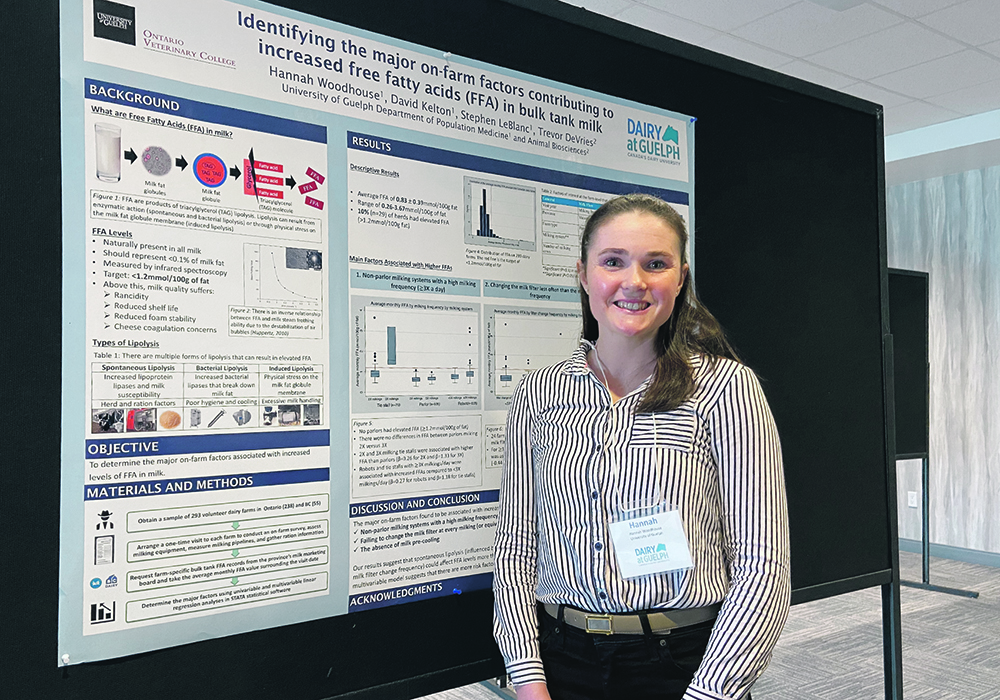The length of lactation, frequency of milking, pre-chilling and filter replacement all contribute to higher free fatty acids
A frothy problem identified by Starbucks baristas in British Columbia does not have a simple solution.
Elevated levels of free fatty acids (FFA) in milk can result in cheese coagulation issues and milk with poor taste, shorter shelf life and a lack of frothing ability, which is the big concern for coffee chains.
The theory when the problem was identified was that it was connected to robotic milking systems and its constant flow of new milking into a bulk tank. Those systems have increased in popularity and are the only major recent change in milk production.
Read Also

Trump’s tariffs take their toll on U.S. producers
U.S. farmers say Trump’s tariffs have been devastating for growers in that country.
However, University of Guelph PhD student Hannah Woodhouse has found that free fatty acid levels in milk can be associated with both tie stall and robotic milking herds.
Their presence can also be tied to the age of the cow, longer lactations and genetics. Parlour-milked herds generally had lower levels. Tie stall farms were more of a concern than robotic milking systems.
However, Woodhouse said farmers don’t need to change their milking systems because not all tie stall and robotic farms had issues. However, they might want to look at how they manage them.
“These farms can help manage those factors, and a lot of these are manageable. They’re very quick and easy fixes,” she said.
Woodhouse recently won the award for top student poster out of close to 90 at the International Dairy Federation’s World Forum in Chicago for her work on free fatty acids.
At the Dairy at Guelph research symposium in Elora, Ont., she said the concern with robotic milking was supported by research in the Netherlands on the same issue, but her research found the problem was much more complex.
Ontario started testing for free fatty acid levels in milk in 2018. B.C. is also testing, and the data from the two provinces gave Woodhouse information to work with.
She said the past few years of testing have found that the levels of free fatty acids in milk in Ontario haven’t changed, but about 10 percent of farms have elevated levels.
“I’m finding that season also plays a role, and FFAs tend to be higher in the late summer and fall months compared to the spring and winter,” she said.
In a search for answers, Woodhouse and her colleagues visited 300 farms, mostly in Ontario but also some in B.C., looking at a wide range of factors from feed to milking systems.
“We were measuring pipelines, looking at any turns or elevated sections of the pipeline.”
They then correlated farming practices with farms that had elevated levels of free fatty acids.
The required changes are usually management alterations. On a farm that milks with robots, for example, producers could limit the number of visits to the robot made by late-lactation cows or dry them off earlier. More frequent milking means the milk that is produced in the cow doesn’t always have enough time to form a membrane before the next milking occurs.
Woodhouse also found increased free fatty acid production during fall incentive days, which encourage farmers to produce more milk in preparation for the holiday and winter season when the demand for milk products is higher.
It’s thought the increase can be tied to greater use of fat supplements during that period to help keep cows healthier as they are pushed to produce more milk.
On tie-stall farms especially, the lack of a plate cooler, which quickly pre-chills the milk as it goes into the bulk tank cooling system, is tied to higher fatty acid levels.
Another simple management change is to make sure to change the milk filter at every milking because that was found to be a factor in higher volatile fatty acids.
The connection between free fatty acids and high fat and low protein levels in milk with has also been found in organic and grass-fed herds.
That all gives Woodhouse plenty to look at in her research.
“We’re just trying to get this research out to dairy farms … because as a supply managed dairy industry, consumer satisfaction of dairy products is one of our main concerns.”















